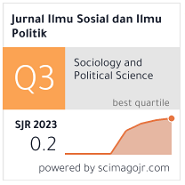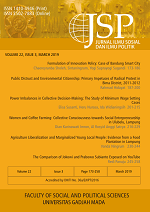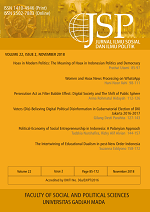Incumbents' Behavior and Strategic Interactions Among Local Governments: The Case of Indonesia
Akhmad Syakir Kurnia(1*), Syahid Izzulhaq(2), Sandy J. Maulana(3)
(1) Department of Economics, Faculty of Economics and Business, Diponegoro University, Semarang, Indonesia
(2) Department of Economics, Faculty of Economics and Business, Diponegoro University, Semarang, Indonesia
(3) Graduate Student, School of International and Public Policy, Hitotsubashi University, Tokyo, Japan
(*) Corresponding Author
Abstract
This paper investigates Yardstick Competition among local governments in decentralized Indonesia by distinguishing bad from good incumbent behavior. By doing so, this paper provides a more explicit connection between theoretical foundation and empirical investigation, where political incumbency is viewed based on the political economy perspective. Given that voters can compare and benchmark their incumbent's performance, an incumbent who aims for the throne twice must consider neighboring local governments' performance as the reference, leading to strategic interaction across local governments. We conduct empirical examinations using Two-regime Spatial Econometrics for panel data consisting of 99 local governments in the West, Central, and East Java Provinces from 2010 to 2017. Our empirical estimation results confirm that mimicking behavior by bad incumbents, characterized by the underperformed public sector, is evident. Bad incumbents mimic their neighbor's public spending. However, we find no evidence of Yardstick Competition by incumbents in general.
Keywords
Full Text:
PDFReferences
Akhmedov, A., & Zhuravskaya, E. (2004). Opportunistic political cycles: Test in a young democracy setting. Quarterly Journal of Economics, 119(4), 1301–1338. https://doi.org/10.1162/0033553042476206
Allers, M. A. (2012). Yardstick competition, fis c al d is parities , and equalizatio n. Economics Letters, 117(1), 4–6. https://doi. org/10.1016/j.econlet.2012.04.076
Allers, M. A., & Elhorst, J. P. (2005). Tax mimicking and yardstick competition among local gov ernments in the Netherlands. International Tax and Public F inance , 12 (4), 493–513. https://doi. org/10.1007/s10797-005-1500-x
Amri, P. D., & Damuri, Y. R. (2019). Economic Voting di Indonesia: Bagaimana Faktor Ekonomi Mempengaruhi Pilihan Politik. Jakarta: CSIS Election Series.
Anselin, L. (1988). Spatial Econometrics: Methods and Models. Springer Science+Business Media Dordrecht. https://doi. org/10.1007/978-94-015-7799-1
Anselin, L., Bera, A. K., Florax, R., & Yoon, M. J. (1996). Simple diagnostic tests for spatial dependence. Regional Science and Urban Economics, 26(1), 77–104. https://doi. org/10.1016/0166-0462(95)02111-6
Arze del Granado, J., Martínez Vázquez, J., & Simatupang, R. (2008). Local government fiscal competition in developing countries: the case of Indonesia. Revista de Economía Pública Urbana = Urban Public Economics Review, 8, 13–45.
Baltagi, B. H. (2005). Econometric Analysis of Panel Data (3rd Editio). UK: John Wiley & Sons Ltd.
Basri, C., & Hill, H. (2020). Making Economic Policy in a Democratic Indonesia: The First Two Decades. Asian Economic Policy Review, 1–21. https://doi.org/10.1111/ aepr.12299
Belleflamme, P., & Hindriks, J. (2005). Yardstick competition and political agency problems. Social Choice and Welfare, 24(1), 155–169. https://doi.org/10.1007/s00355-003-0297-8
Besley, T., & Case, A. (1995). Incumbent Behavior: Vote-Seeking, Tax-Setting, and Yardstick Competition. American Economic Review, 85(1), 25–45.
Block, S. A. (2002). Political business cycle, democratization, and economic reform: The case of Africa. Journal of Development Economics, 67(1), 205–228. https://doi. org/10.1016/S0304-3878(01)00184-5
Boarnet, M. G., & Glazer, A. (2002). Federal grants and yardstick competition. Journal of Urban Economics, 52(1), 53–64. https://doi.org/10.1016/S0094-1190(02)00001-3
Bocci, C., Ferretti, C., & Lattarulo, P. (2019). Spatial interactions in property tax policies among Italian municipalities. Papers in Regional Science, 98(1), 371–391. https://doi.org/10.1111/pirs.12341
Brender, A., & Drazen, A. (2005). Political budget cycles in new versus established democracies. Journal of Monetary Economics, 52(7), 1271–1295. https://doi.org/10.1016/j. jmoneco.2005.04.004
Caldeira, E. (2012). China Economic Review Yardstick competition in a federation : Theory and evidence from China. China Economic Review, 23(4), 878–897. https://doi.org/10.1016/j.chieco.2012.04.011
Chalil, T. M. (2020). Fiscal competitions among Indonesian municipalities: a spatial econometric analysis. Asia-Pacific Journal of Regional Science, 4(1), 241–260. https:// doi.org/10.1007/s41685-019-00138-3
Chua, C. (2009). Capitalist consolidation, consolidated capitalists: indonesia’s conglomerates between authoritarianism and democracy. In M. Bunte and. A. Ufen. (Ed.), democratization in post-Suharto Indonesia,. London & New York: Routledge Contemporary Souteast Asia Studeis.
Di Liddo, G., & Giuranno, M. G. (2016). Asymmetric yardstick competition and municipal cooperation. Economics Letters, 141, 64–66. https://doi.org/10.1016/j.econlet.2016.01.015
Elhorst , J. P. (2010). Applied Spatial Econometrics: Raising the Bar. Spatial Economic Analysis, 5(1), 9–28. https://doi. org/10.1080/17421770903541772
Elhorst, J. P. (2014). Spatial Econometrics From Cross-Sectional Data to Spatial Panels (H. Folmer, M. Partridge, G. Duranton, D. P. McMillan, A. Rodriguez-Pose, & H. W. C. (eds.); Vol. 16). Springer International Publishing. https://doi.org/10.1007/978-3-642-40340-8
Elhorst, J. P., & Freret, S. (2009). Evidence of Political Yardstick Competition In France Using A Two-Regime Spatial Durbin Model With Fixed Effects. Journal of Regional Science, 49, 931-951. https://doi. org/10.1111/j.1467-9787.2009.00613.x
Farah, A. (2019). Fiscal disparity, institutions and asymmetric yardstick competition. Economics Letters, 181, 74–76. https://doi. org/10.1016/j.econlet.2019.04.029
Fossati, D. (2019). The Resurgence of Ideology in Indonesia: Political Islam, Aliran and Political Behaviour. Journal of Current Southeast Asian Affairs, 38(2), 119–148. https://doi.org/10.1177/1868103419868400
Fossati, D., A s pinall, E ., M uhtad i, B ., & Warburton, E. (2020). Ideological representation in clientelistic democracies: The Indonesian case. Electoral Studies, 63 ( July 2019), 102111. https:// doi. org/10.1016/j.electstud.2019.102111
Hory, M. P. (2018). Delayed mimicking: the timing of fiscal interactions in Europe. European Journal of Political Economy, 55(December 2016), 97–118. https://doi. org/10.1016/j.ejpoleco.2017.11.005
LeSage, J., & Pace, R. K. (2009). Introduction to Spatial Econometrics. In N. Balakrishnan & W. R. Schucany (Eds.), Introduction to Spatial Econometrics. London & New York: Taylor & Francis Group, LLC.
Lewis, B. D., Nguyen, H. T. M., & Hendrawan, A. (2020). Political accountability and public service delivery in decentralized Indonesia: Incumbency advantage and the performance of second term mayors. European Journal of Political Economy,64(June), 101910. https://doi.org/10.1016/j. ejpoleco.2020.101910
Mietzner, M. (2008). Comparing Indonesia’s party systems of the 1950s and the post-Suharto era: From centrifugal to centripetal inter-party competition. Journal of Southeast Asian Studies, 39(3), 431–453. https://doi.org/10.1017/S0022463408000337
Mietzner, M. (2010). Indonesia’s Direct Elections: Empowering the Electorate or Entrenching the New Order Oligarchy? In E. Aspinall & G. Fealy (Eds.), Soeharto’s New Order and Its Legacy: Essays in honour of Harold Crouch (pp. 173–190). Australia: ANU Press.
Mondak, J. J. (1995). Competence, integrity, and the electoral success of congressional incumbents. The Journal of Politics, 57(4), 1043–1069. https://doi. org/10.2307/2960401
Revelli, F. (2006). Performance rating and yardstick competition in social service provision. Journal of Public Economics, 90(3), 459–475. https://doi.org/http://dx.doi.org/10.1016/j.jpubeco.2005.07.006
Revelli, F., & Tovmo, P. (2007). Revealed yardstick competition: Local government efficiency patterns in Norway. Journal of Urban Economics, 62(1), 121–134.
Robinson, R., and V. H. (2004). Reorganising power in Indonesia: The politics of oligarchy in an age of markets. London & New York: Routledge.
Rodden, J. (2002). The Dilemma of Fiscal Federalism : Grants and Fiscal Performance around the World. 46(3), 670–687.
Santolini, R. (2020). Spatial effects on local government efficiency. Papers in Regional Science , 99 (1), 183–200. https://doi. org/10.1111/pirs.12475
Schaltegger, C. A., & Küttel, D. (2002). Exit, voice, and mimicking behavior: Evidence from Swiss cantons. Public Choice, 113(1–2), 1–23. https://doi.org/10.1023/A:1020377207035
Schuknecht, L. (2000). Fiscal policy cycles and public expenditure in developing countries. Public Choice, 102(1–2), 115–130. https://doi.org/10.1023/A:1005026806998
Shi, M., & Svensson, J. (2006). Political budget cycles: Do they differ across countries and why? Journal of Public Economics, 90(8–9), 1367–1389. https://doi.org/10.1016/j. jpubeco.2005.09.009
Sjahrir, B. S., Kis-Katos, K., & Schulze, G. G. (2013). Political budget cycles in Indonesia at the district level. Economics Letters, 120(2), 342–345. https://doi.org/10.1016/j.econlet.2013.05.007
Solé-Ollé, A. (2006). Expenditure spillovers and fiscal interactions: Empirical evidence from local governments in Spain. Journal of Urban Economics, 59(1), 32–53. https:// doi.org/10.1016/j.jue.2005.08.007
Tyson, A. D. (2010). Decentralization and adat revivalism in Indonesia: The politics of becoming indigenous. In Decentralization and Adat Revivalism in Indonesia: The Politics of Becoming Indigenous. https://doi. org/10.4324/9780203849903
Vergne, C. (2009). Democracy, elections and allocation of public expenditures in developing countries. European Journal of Political Economy, 25(1), 63–77. https://doi. org/10.1016/j.ejpoleco.2008.09.003
Article Metrics
Refbacks
- There are currently no refbacks.
Copyright (c) 2022 Jurnal Ilmu Sosial dan Ilmu Politik

This work is licensed under a Creative Commons Attribution-NonCommercial-NoDerivatives 4.0 International License.






















